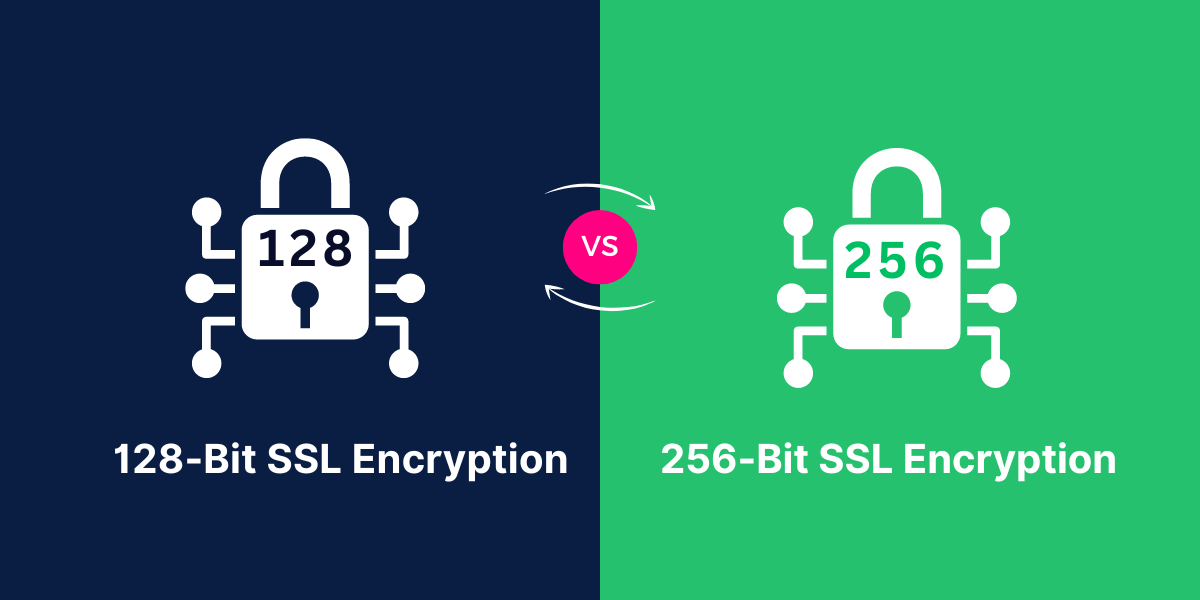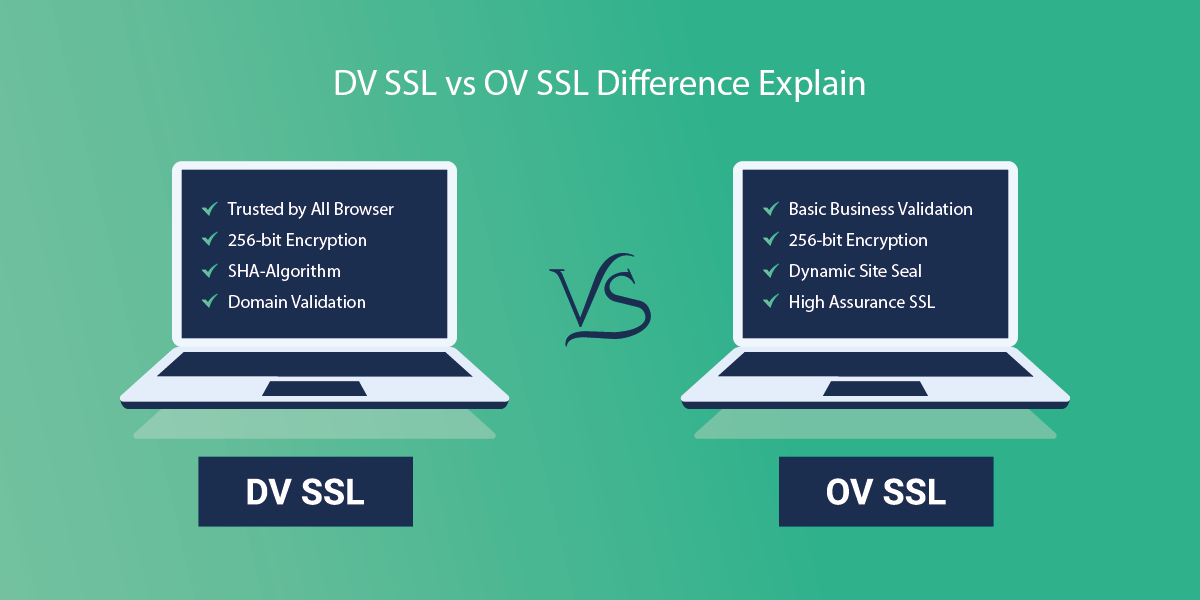What’s the Difference Between 128-Bit SSL and 256-Bit SSL Encryption
As online communication and commerce continue to grow, secure connections have become increasingly crucial. When it comes to secure connections, one of the most important components is SSL (Secure Sockets Layer) encryption, which comes in different key lengths like 128-bit and 256-bit. This article will examine the differences between 128-Bit vs 256-Bit SSL Encryption, comparing the technical differences between the two key lengths, the level of security they each provide, and looking at the advantages and disadvantages of each.
With more and more sensitive data being transmitted online, website owners must make informed decisions when choosing which SSL certificate and encryption strength to use for their sites. Understanding the differences between 128-bit and 256-bit SSL can help with this. The various compatibility issues and security implications of each key length will be explored.
Key Takeaways
- 128-bit and 256-bit refer to the key lengths used in SSL/TLS encryption protocols to secure data transmission over the internet.
- 256-bit Encryption is stronger than 128-bit as it has a longer key length, providing better Security with 2^128 times more possible keys.
- Many organizations are transitioning from 128-bit to 256-bit Encryption due to its enhanced Security and to meet compliance standards.
- 128-bit Encryption is still considered secure enough for basic web browsing but may not be suitable for highly sensitive data.
- Factors like encryption algorithms, proper implementation, and key management, in addition to key length, also impact the strength of Encryption.
Head to Head Comparison Between 128-Bit vs 256-Bit SSL Encryption
|
Feature |
128-bit SSL |
256-bit SSL |
|
Key Length |
128 bits |
256 bits |
|
Possible Keys |
3.4 x 10^38 |
1.1 x 10^77 |
|
Brute Force Resilience |
Vulnerable |
Extremely resilient |
|
Security Level |
Basic |
Very high |
|
Compliance Standards |
Below baseline |
Meets modern standards |
|
Supported Protocols |
SSL, TLS |
SSL, TLS |
|
Encryption Algorithms |
AES, RC4, 3DES |
AES, RC4, 3DES |
|
Implementation |
Widely supported |
Needs some upgrades |
|
Cost |
Low |
Moderate |
|
Speed |
Faster |
Marginally slower |
|
Future Proofing |
Inadequate |
Highly future-proof |
|
Recommended Usage |
Non-critical data |
Sensitive data |
What is 128-bit SSL Encryption?
128-bit SSL was introduced in the 1990s as a replacement for 40-bit and 56-bit Encryption, which were prone to brute-force attacks. It uses a 128-bit key to encrypt and decrypt data exchanged between two systems, typically a web browser and a web server.
Some key facts about 128-bit SSL encryption:
- Uses asymmetric or public key cryptography with a paired public and private 128-bit key for encryption/decryption.
- Provides around 3.4 x 10^38 possible keys, making it resistant to brute force attacks.
- It supports multiple symmetric encryption ciphers, such as AES, RC4, 3DES, etc., to encrypt data after an asymmetric key exchange.
- Offers Security sufficient for basic web browsing and non-critical data transmissions.
- Supported across all modern web browsers and servers.
During the initial SSL handshake, the server sends its public key to the client, who uses it to encrypt a symmetric session key and send it back. This session key is then used to encrypt all subsequent data exchanges under the secured SSL session.
In the 1990s, 128-bit Encryption was considered the gold standard for SSL security. However, as computing power increased exponentially, it became vulnerable to brute-force attacks. This led to the introduction of a more robust 256-bit Encryption.
What is 256-bit SSL Encryption?
256-bit SSL improves on 128-bit Encryption by using even longer asymmetric keys for establishing secure connections. Some key facts:
- It uses a 256-bit public-private key pair for encrypting the symmetric session key.
- It provides approximately 1.1 x 10^77 possible keys, making it virtually unbreakable by brute force.
- It builds on the same SSL/TLS framework as 128-bit but with enhanced key strength.
- It provides very high-grade Security that is suitable for sensitive data like health records, financial transactions, etc.
- More resilient to mathematical cryptanalysis attacks than 128-bit Encryption.
- Supported on modern browsers and servers, it may need firmware updates for older systems.
With a 256-bit key, there are 2^128 times more possible key combinations compared to 128-bit. This makes it practically impossible for attackers to find the right private key by guessing all combinations, even with access to vast computing resources.
256-bit SSL is increasingly becoming the new standard for internet security to prevent sophisticated cyber attacks that exploit weaknesses in older encryption protocols.
Difference Between 128-Bit vs 256-Bit Encryption
The main difference between the two encryption standards is the length of the asymmetric private and public keys used initially to establish the SSL/TLS connection:
- 128-bit keys are 128 bits long, while 256-bit keys are 256 bits in length.
- 128-bit has around 3.4 x 10^38 possible keys while 256-bit has 1.1 x 10^77 possible key combinations.
- This makes 256-bit approximately 2^128 times stronger in terms of brute force resilience.
- 128-bit is sufficient for general websites, but high-risk platforms should use 256-bit Encryption.
- 256-bit is progressively superseding 128-bit as the minimum security standard for financial, government, and healthcare industries.
- Both standards are otherwise identical in their overall SSL/TLS working, cipher support, and implementation.
- The longer key size makes 256-bit slower in performance compared to 128-bit, but not to a very noticeable extent.
Security Comparison: 128-Bit vs 256-Bit Encryption
Though 128-bit was once deemed unbreakable, modern computing capabilities have rendered it potentially vulnerable:
128-Bit Security
- Brute force attacks are now possible, given enough computational power.
- Mathematical weaknesses have been found over time, decreasing its effective key size.
- Recommended minimum by NIST only until 2010, not enough for high confidentiality needs.
- It provides basic Security for casual web use but needs to be more for sensitive data.
- It is still widely used by websites for general visitor access due to legacy support.
256-Bit Security
- It is effectively impossible to break using brute computational power.
- No mathematical vulnerabilities are known yet due to the longer key size.
- Minimum standard mandated by many regulators and data protection laws.
- Provides very high-grade Security for critical communications and data.
- Widely adopted across sectors like finance, healthcare, government, and payment systems.
While 128-bit Encryption is likely to remain secure for normal website use in the near future, it is prudent to transition to 256-bit Encryption for elevated security needs as it offers vastly better cryptographic protection.
When Does 256-Bit Encryption Become Necessary?
Here are some general scenarios where migrating from 128-bit to 256-bit SSL/TLS encryption is recommended or mandated:
- Websites handling sensitive user information like financial, medical, and government data.
- Companies operating in regulated sectors are subject to stringent compliance rules.
- Organizations seeking security certifications like ISO 27001, PCI DSS, HIPAA, etc.
- Financial institutions protect payment systems and online transactions.
- Cloud service providers secure customer data across public networks.
- Any website upgraded to HTTPS that wants the latest encryption standard.
- New systems and software are going through security design review processes.
- Legacy applications are undergoing major upgrades or periodic hardening.
- After any major cryptographic breakthrough that impacts shorter key lengths.
The above contexts typically require 256-bit Encryption, either due to security best practices or because industry regulations such as HIPAA and GLBA mandate it as the baseline standard.
For non-critical websites like simple blogs or informational pages, 128-bit Encryption remains adequately secure for now, and upgrading is optional. The need depends on the sensitivity of user data handled.
Additional Factors Impacting SSL/TLS Encryption Strength
While key length is the primary determinant of encryption robustness, some other aspects also matter:
- Encryption Protocol: Using the latest TLS 1.3 is better than outdated SSL 3.0 or TLS 1.0 versions.
- Supported Ciphers: Stronger ciphers like AES-256 are preferred over older ones like RC4, DES, 3DES, etc.
- Digital Certificates: Extended Validation (EV) certificates provide the highest authentication.
- Proper Implementation: Correct SSL configuration as per best practices improves Security.
- Key Management: Private keys should be securely generated, stored, and rotated periodically.
- Connection Protocol: Direct HTTPS connections are safer than proxied HTTPS.
Final Thoughts
In conclusion, while both 128-bit and 256-bit SSL provide secure encrypted channels for internet data transmission, 256-bit Encryption is unequivocally stronger and has become the new standard. With its exponentially larger key size of 2^128 times more combinations, 256-bit SSL offers far superior protection against brute force attacks compared to 128-bit Encryption.
Organizations handling valuable data should proactively upgrade to leverage the cryptographic resilience of 256-bit SSL and align with modern compliance requirements.
Frequently Asked Questions
What is 128-bit SSL encryption?
128-bit SSL is an older encryption standard that uses a 128-bit key to encrypt data sent between a web browser and web server. It is less secure than 256-bit encryption.
What is 256-bit SSL encryption?
256-bit SSL uses a 256-bit key for encryption, making it stronger than 128-bit encryption. It provides better security for sensitive data transmission over the internet.
Is 128-bit encryption secure?
128-bit encryption is considered secure enough for basic web browsing but may be vulnerable to attacks by well-funded adversaries. 256-bit is recommended for higher security.
What is the difference between 128-bit vs 256-bit SSL?
The main difference is the key length – 128-bits vs 256-bits. 256-bit provides exponentially stronger encryption, making it harder to crack.
Why has 256-bit SSL replaced 128-bit?
The longer 256-bit keys provide better security against brute force attacks. Many organizations have transitioned to 256-bit as computer processing power has increased.
Is 256-bit SSL necessary for most websites?
For basic websites, 128-bit may be sufficient, but 256-bit is recommended for sites handling sensitive user data like finances or health information.

Priya Mervana
 Verified Web Security Experts
Verified Web Security Experts
Priya Mervana is working at SSLInsights.com as a web security expert with over 10 years of experience writing about encryption, SSL certificates, and online privacy. She aims to make complex security topics easily understandable for everyday internet users.



